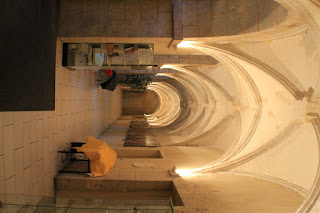I took a train to Cambridge on Thursday in order to visit King's Chapel, where you are more likely to be run over by a bike than a car when the colleges are in session. I took a two hour tour with a local guide named Rosalyn, who has been leading tours of Cambridge for the last twenty two years. She pointed out many of the structures from the Middle Ages and provided interesting commentary on the history of Cambridge.
St. Benedict's Church constructed in the 1500's has the oldest building in Cambridge, a bell tower c. 1027, attached to it. They still
use the bell tower to call people to church, the bells are rung from
the ground floor.
The people would gather together in the ante chapel prior to the service, it is here that the carving is most elaborate. It is a rather large ante chapel, where people would have originally stood. The windows were put in during various stages in the 1500's. All the glass was removed during the second world war, with the exception of the west window. The wooden organ screen, that separates the west and east portions of the chapel, was carved in during Henry VIII and Anne Boleyn's brief three year marriage (1553-1556).
 |
| Fan vault ceiling inside King's Chapel |
|
|
|
|
|
|
In England the building of cathedrals, chapels, and churches were started at the east end with the west end being completed much later. The choir and alter are located in the east end. Originally exquisite ceilings like this would have been painted, however due to fighting wars they ran out of funding. While this English Perpendicular fan ceiling is not the oldest example in the country but it is the largest (80 feet or 23 1/2 meters), created in 1512-1515.
 |
| String course in the ante chapel |
The one of the stone carvers felt that he did such a superb job carving the walls of the chapel that he put a self portrait of himself in the string course, a little row of flowers. (located to the far left above the arch)
In the great gate of Trinity College Cambridge there is a statue that depicts Henry VIII, who had the original sculpture of Edward III removed five weeks prior to his death. His left hand once held a scepter, but it now holds a wooden chair leg which was placed there by college students playing pranks once they have completed their final exams. In the past they have inserted other objects including a bicycle pump and a "lavatory brush". The college now leaves the wooden chair leg.

Today you cannot see in or out many of the structures of the Middle Ages as many of the windows were cemented in to save money, when taxes in the 17th and 18th century were calculated by the number of windows that a building contained.









































 Today you cannot see in or out many of the structures of the Middle Ages as many of the windows were cemented in to save money, when taxes in the 17th and 18th century were calculated by the number of windows that a building contained.
Today you cannot see in or out many of the structures of the Middle Ages as many of the windows were cemented in to save money, when taxes in the 17th and 18th century were calculated by the number of windows that a building contained. 







